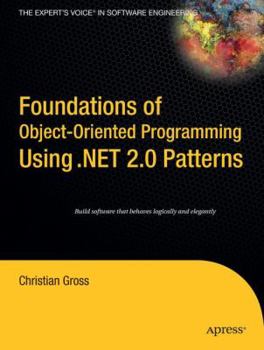Foundations of Object-Oriented Programming Using .Net 2.0 Patterns
The focus of this book is to present object-oriented programming using .NET patterns. Patterns are currently being largely taught based on the assumption that the reader understands object oriented programming techniques. This has resulted in another gap as the techniques taught often clash with the techniques used by the reader. The pattern concept is also abstract and often fails to make the jump from theory to practical. The purpose of...
Format:Paperback
Language:English
ISBN:1590595408
ISBN13:9781590595404
Release Date:October 2005
Publisher:Apress
Length:376 Pages
Weight:1.60 lbs.
Dimensions:0.9" x 7.1" x 9.3"
Related Subjects
Computer Science Computers Computers & Technology Education & Reference Languages & Tools Object-Oriented Design Object-Oriented Software Design Programming Programming Languages Software Design & Engineering Software Design, Testing & Engineering Software Development Web Design Web Development & DesignCustomer Reviews
4 ratings
Well Written
Published by Thriftbooks.com User , 18 years ago
I totally disagree with 'E. Makepeace "Ewan"'. But there's always at least one hater in the group, who hates just to hate. I've been searching for a book like this for a long time; one that is C# flavor that not only defines patterns, but explains how and why to use them. My schooling focused on OOP concepts but never touched on patterns. The author supplies many good examples and explains concepts in an easy to understand manner. Highly recommended...
Solid Book on Using Patterns in C#
Published by Thriftbooks.com User , 18 years ago
This is defnitely an advanced topic, not Beginner/Intermediate level. The chapter on Generics is excellents and there are some good examples on using patterns in C#. The book flows very smoothly, and the author provides excellent concepts on using patterns with .NET 2.0. If you don't have experience in object-oriented techniques this book may a little much. The chapter on OO while good, may require a re-read to understand topics in the other chapters. All in all I would recommend this book. The author shows some excellent techniques on the best way to use Gang of Four patterns with .NET 2.0.
Explains Things In a Style that Helped Me Understand
Published by Thriftbooks.com User , 18 years ago
To those of us who started programming back in the dark, dark ages when languages didn't have any 'object orientation' to them but were procedural in nature the new concept of OO is particularly difficult to grasp. So many books start out with a definition of OO something like "an object can be anything ...' Obviously this is BS because that cup of tea sitting on my desk is an object but has little to do with programming. Then these books don't mention objects again for a hundred pages or more. If we've had to write using an OO language, we tend to copy down the stuff that goes at the beginning and end of the program and then write the programming using an OO language but using a procedural style. This book is different. He starts out with a chapter on essentials of OO programming. And By Golly, what he says makes sense. What I'm saying is that he has a writing style that appeals to me, makes sense to me, that approaches the problem in a way that I can understand. This book explains several concepts, OO, Patterns, C#, .NET 2.0 in sufficient detail to get a grasp of what we're trying to do without being so detailed that we get bogged down in a pit so deep that we can't see out. After reading it, I'm ready to move on to learning more of each of these subjects, as well as some others that he touched on.
Good Patterns Book
Published by Thriftbooks.com User , 19 years ago
This book is a very good patterns book. The author covers a lot of ground and has a lot of real practical examples. I would recommend reading it. The author relates patterns to architecture, component based development, data persistence, pluggable architectures, algorithms, code efficiency, and a ton of other great topics. He also relates the topics to real world scenarios, so it is all very practical. He also uses TDD to build tests to show how to test the implementations of the components he builds. The author also make extensive use of Generics, which lend themselves very well to patterns. He has some great examples of how to use them to modify the tradition GOF patterns to make the more .NET 2.0 savvy. He also points out when to use interfaces and when it is appropriate to use classes in component development, which is very important to know. Over all I think the author does a great job of showing how to use patterns in real life OOP. There are two downsides to the book. One is the style in which it is written. Things are broken down very well and you need to really pay attention to what points the author is making. The other down side it the downloadable code. It is a chaotic mess and it's not usable.






